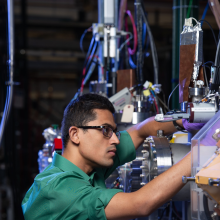-
Title
Postdoctoral Researcher -
Email
jain15@llnl.gov -
Phone
(925) 422-1701 -
Organization
PLS-NACSD-NUCLEAR & CHEMICAL SCIENCE DIVISION
Rahul Jain’s research interests are in the field of nuclear astrophysics including nuclear experiments and statistical analysis of nuclear data. His PhD thesis work at Michigan State University (MSU) was based on the experimental b-decay of 33Mg including b-delayed g and neutron emission using Total Absorption Spectroscopy (TAS) to constrain the rate of Urca cooling in accreting neutron star crusts. His thesis also included constructing a data-driven nuclear mass model using Bayesian Machine Learning techniques for accurate modeling of neutron star crusts. As a graduate student at the Facility for Rare Isotope Beams (FRIB) at MSU, he participated and contributed to multiple nuclear physics experiments using a variety of experimental set-ups including the SECAR Recoil Separator, FRIB Decay Station initiator (FDSi), AT-TPC Time Projection Chamber, GADGET-II, etc.
As a postdoc at Lawrence Livermore National Laboratory (LLNL), he is developing a new indirect measurement technique using the upcoming tritium beam facility at Florida State University (FSU) to experimentally constrain the neutron-capture cross sections on unstable nuclei for heavy element nucleosynthesis in the slow neutron-capture process (s-process). He is using the Super Enge Split Pole Spectrograph (SE-SPS) and the CeBrA g-ray detector array at FSU for these measurements. Additionally, he is also building ‘ReacTool’ to simulate spectra from nuclear reactions that can aid in experimental design and planning.
Ph.D. Nuclear Physics, Michigan State University, US, 2024
M.S. Physics, Michigan State University, US, 2021
Integrated M.Sc. Physics, Indian Institute of Technology Roorkee, India, 2018
“Machine Learning enabled measurements of astrophysical (p,n) reactions with the SECAR recoil separator”
P. Tsintari et al., Physical Review Research 7, 013074 (2025)
“Low spin spectroscopy of neutron-rich 43,44,45Cl via β− and βn decay”
V. Tripathi et al., Physical Review C 109, 044320 (2024)
“Proton shell gaps in N=28 nuclei from the first complete spectroscopy study with FRIB Decay Station Initiator”
I. Cox et al., Physical Review Letters 132, 152503 (2024)
“Impact of Pycnonuclear Fusion Uncertainties on the Cooling of Accreting Neutron Star Crusts”
R. Jain et al., The Astrophysics Journal 955, 51 (2023)
“β-decay of neutron-rich 45Cl located at the magic number N = 28 ”
S. Bhattacharya et al., Physical Review C 108, 024312 (2023)
“β-decay of 36Mg and 36Al: Identification of β-decaying isomer in 36Al”
R. S. Lubna et al., Physical Review C 108, 014329 (2023)
“Microsecond Isomer at the N = 20 Island of Shape Inversion Observed at FRIB”
T. J. Gray et al., Physical Review Letters 130, 242501 (2023)
“Crossing N = 28 Toward the Neutron Drip Line: First Measurement of Half-Lives at FRIB”
H. L. Crawford et al., Physical Review Letters 129, 212501 (2022)
“Evidence of a Near-Threshold Resonance in 11B Relevant to the β-Delayed Proton Emission of 11Be”
Y. Ayyad et al., Physical Review Letters 129, 012501 (2022)
“57Zn β-delayed proton emission establishes the 56Ni rp-process waiting point bypass”
M. Saxena et al., Physics Letters B 829, 137059 (2022)
“Horizons: nuclear astrophysics in the 2020s and beyond”
H. Schatz et al., Journal of Physics G: Nuclear and Particle Physics 49, 110502 (2022)
“Online Bayesian optimization for a recoil mass separator”
S. A. Miskovich et al., Physical Review Accelerators and Beams 25, 044601 (2022)
“The impact of neutron transfer on heating and cooling of accreted neutron star crusts”
H. Schatz et al., The Astrophysical Journal 925, 205 (2022)
“Precision mass measurement of lightweight self-conjugate nucleus 80Zr”
A. Hamaker, E. Leistenschneider, R. Jain et al., Nature Physics 17, 1408-1412 (2021)
“First direct measurement of 59Cu(p, α)56Ni: A step towards constraining the Ni-Cu cycle in the cosmos”
J. S. Randhawa et al., Physical Review C Letters 104, L042801 (2021)
- IReNA Visiting Fellowship to travel to the University of Oslo, Norway for 4 weeks in August 2025, International Research Network for Nuclear Astrophysics (IReNA), 2025.
- AGEP Scholar Award for outstanding service to the Alliance for Graduate Education and the Professoriate (AGEP) at Michigan State University, 2024.
- People’s choice award for 3 Minute Thesis (3MT) presentation titled ‘Mimicking the stars in our laboratory’, Michigan State University, 2023.
- Konrad Gelbke Award for Presentation titled ‘Seeing the invisible: First Image of a Black Hole with the EHT’, Dept. of Physics & Astronomy, Michigan State University, 2022.
- Institute Gold Medal for graduating top of class with distinction, Indian Institute of Technology Roorkee, 2018.
- IITR Encore Award for all-round excellence in academics, extra-curriculars, and overall leadership, Indian Institute of Technology Roorkee (IITR), 2016
- KVPY Young Scientist Fellowship to pursue a career in fundamental sciences by the Indian Institute of Science, 2013.


